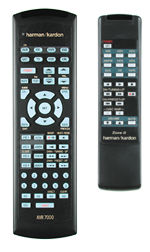Harman/Kardon AVR 7000 A/V Receiver Page 3
 With so much competition these days, receivers can live and die on the peripherals. The AVR 7000 is pretty well-covered in this department. The remote is comprehensive and well-laid-out, and I'm glad to see that Harman has resisted the temptation to include a cheap touchscreen with this receiver, as some of the competition has done. Backlighting is an important plus, and—like most good receiver remotes—this one can be programmed easily to control your other components. The manual is straightforward and helpful; setup shouldn't be a problem for anyone with a basic A/V understanding.
With so much competition these days, receivers can live and die on the peripherals. The AVR 7000 is pretty well-covered in this department. The remote is comprehensive and well-laid-out, and I'm glad to see that Harman has resisted the temptation to include a cheap touchscreen with this receiver, as some of the competition has done. Backlighting is an important plus, and—like most good receiver remotes—this one can be programmed easily to control your other components. The manual is straightforward and helpful; setup shouldn't be a problem for anyone with a basic A/V understanding.
The big front panel is informative and relatively attractive, and it offers a unique bonus: Its S-video and composite inputs can be configured for input or output in the onscreen menus. This is a nice touch, offering several possibilities. Most configuring can be accomplished with the remote and the front-panel display, although the onscreen menus are certainly more efficient. Settings like delay (adjustable only in Dolby Digital and Pro Logic modes) and cross-over frequencies are stored in memory according to the surround mode selected, while individual channel levels are stored both by surround mode and input selected. This can be handy for sources like DVD players or satellite receivers that you're probably using multiple surround modes with—you don't have to adjust the settings when you switch between modes.
The AVR 7000's positioning in the grand scheme of things offers some interesting options to consider. If you're looking for a receiver whose performance is a cut above but aren't sure you want to spend the $2,000-plus that most other top-shelf models go for, give this Harman an audition. The lack of EX and THX processing must be considered (especially when the $1,999 Denon AVR-4800 we reviewed last month offers both) but shouldn't be given more emphasis than it deserves. EX, or "5.1+"-channel processing of some sort, can always be addressed in the future when there's more software support. Build quality is excellent on the AVR 7000, there are plenty of worthwhile perks, and—like most quality models in this category—it makes home theater easy. A little simplicity can go a long way these days.
Highlights
• Plenty of perks (e.g., HDCD decoding, second-zone output)
• Well-rounded performance with movies and music
• Component video switching
























































